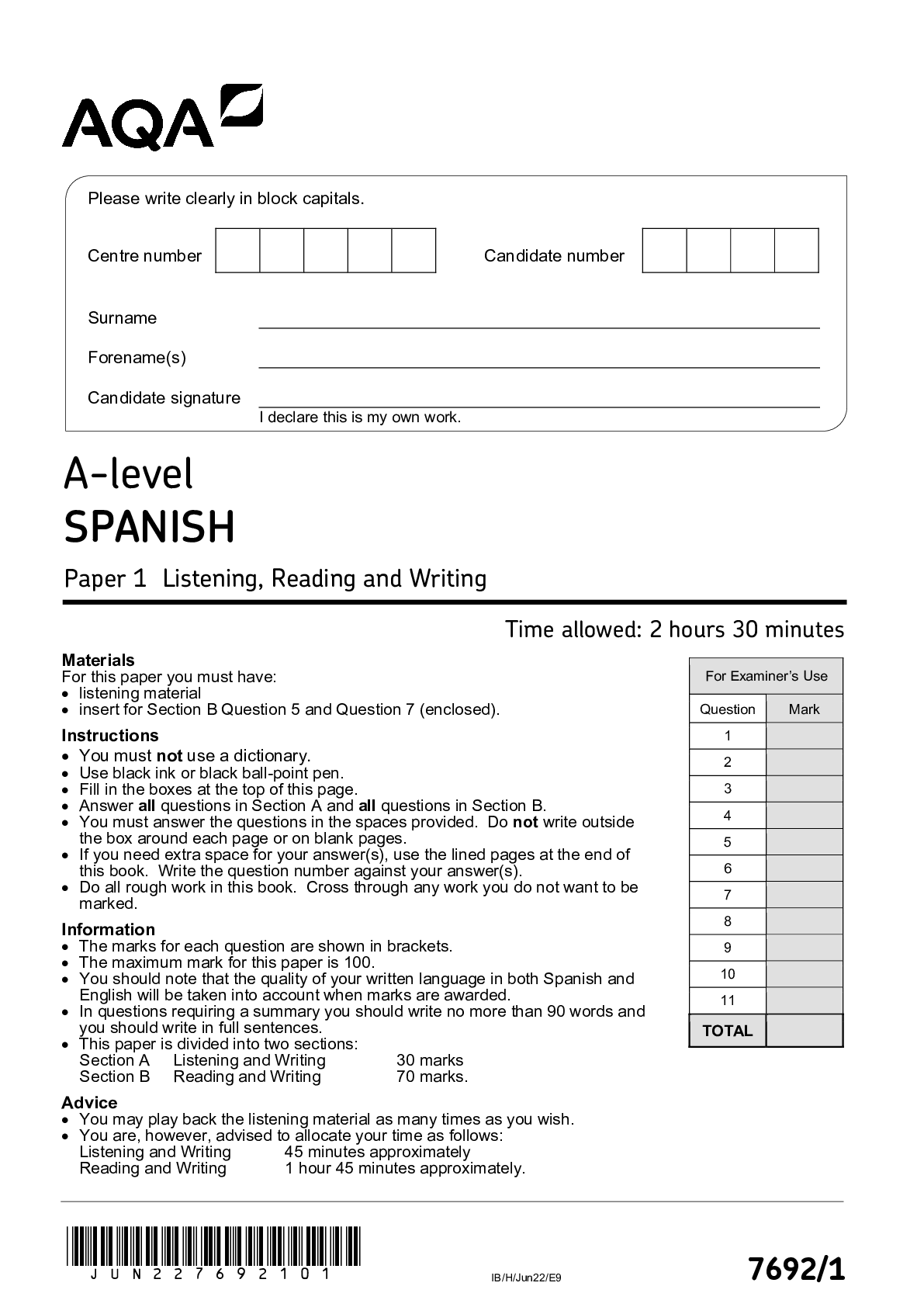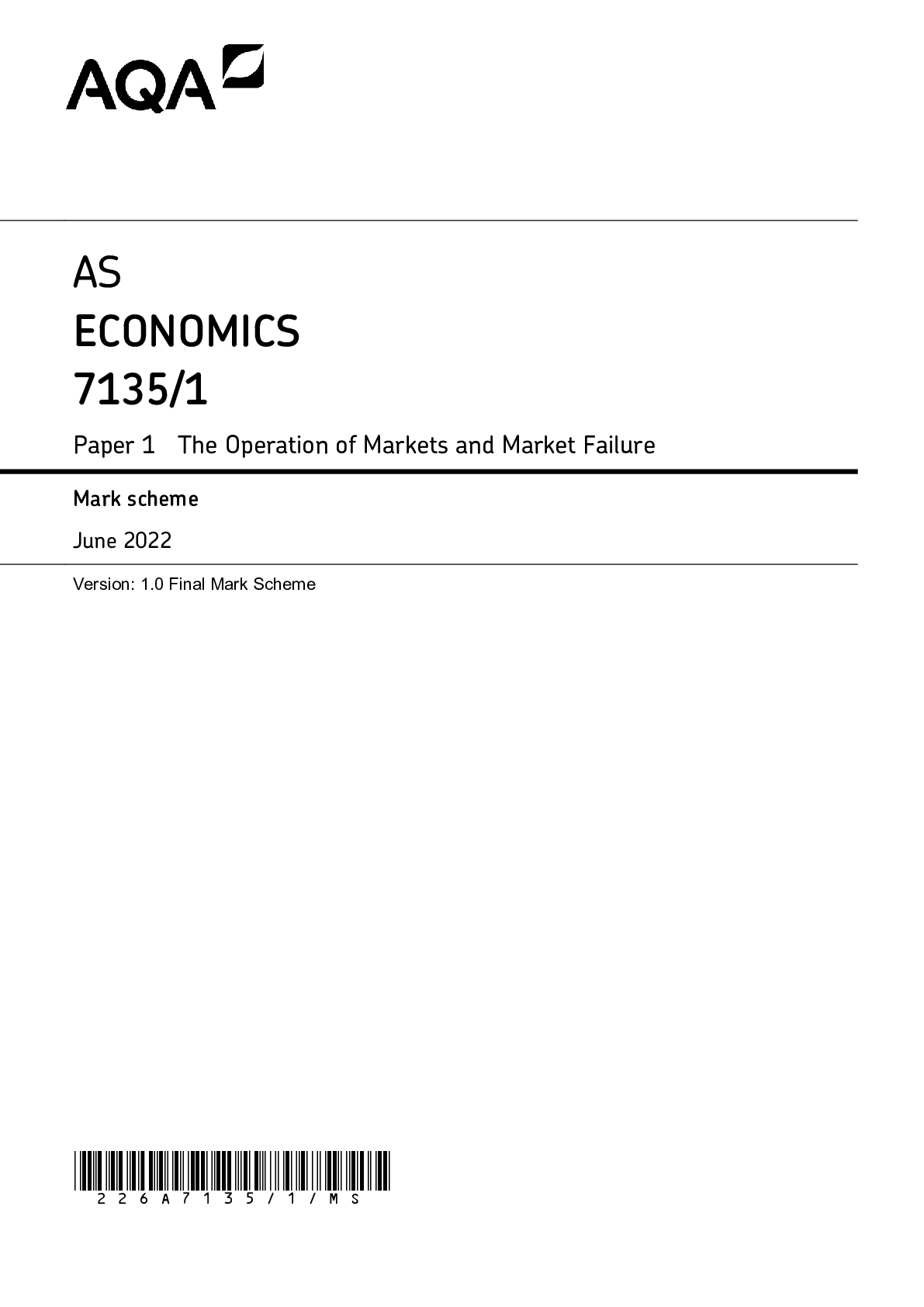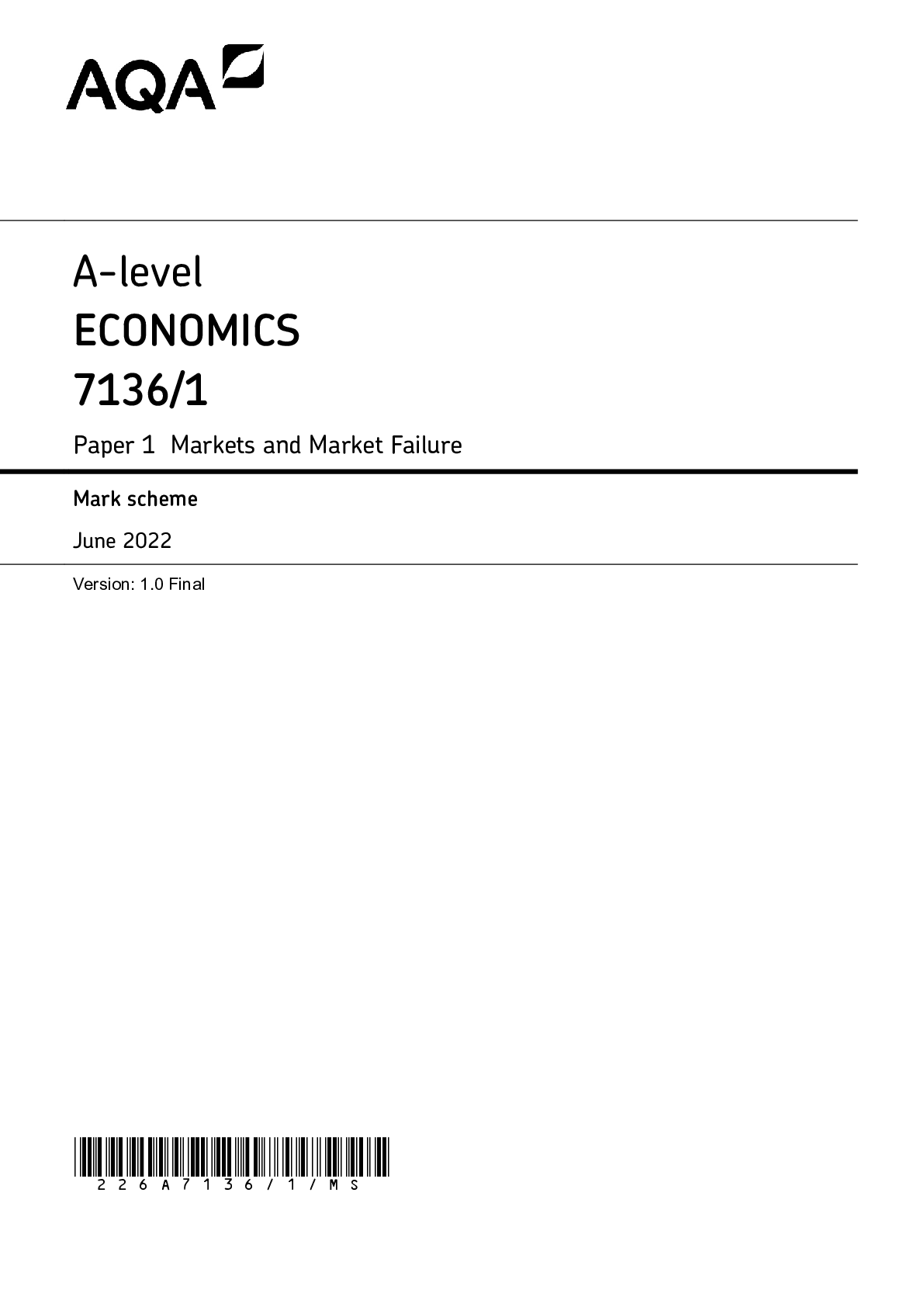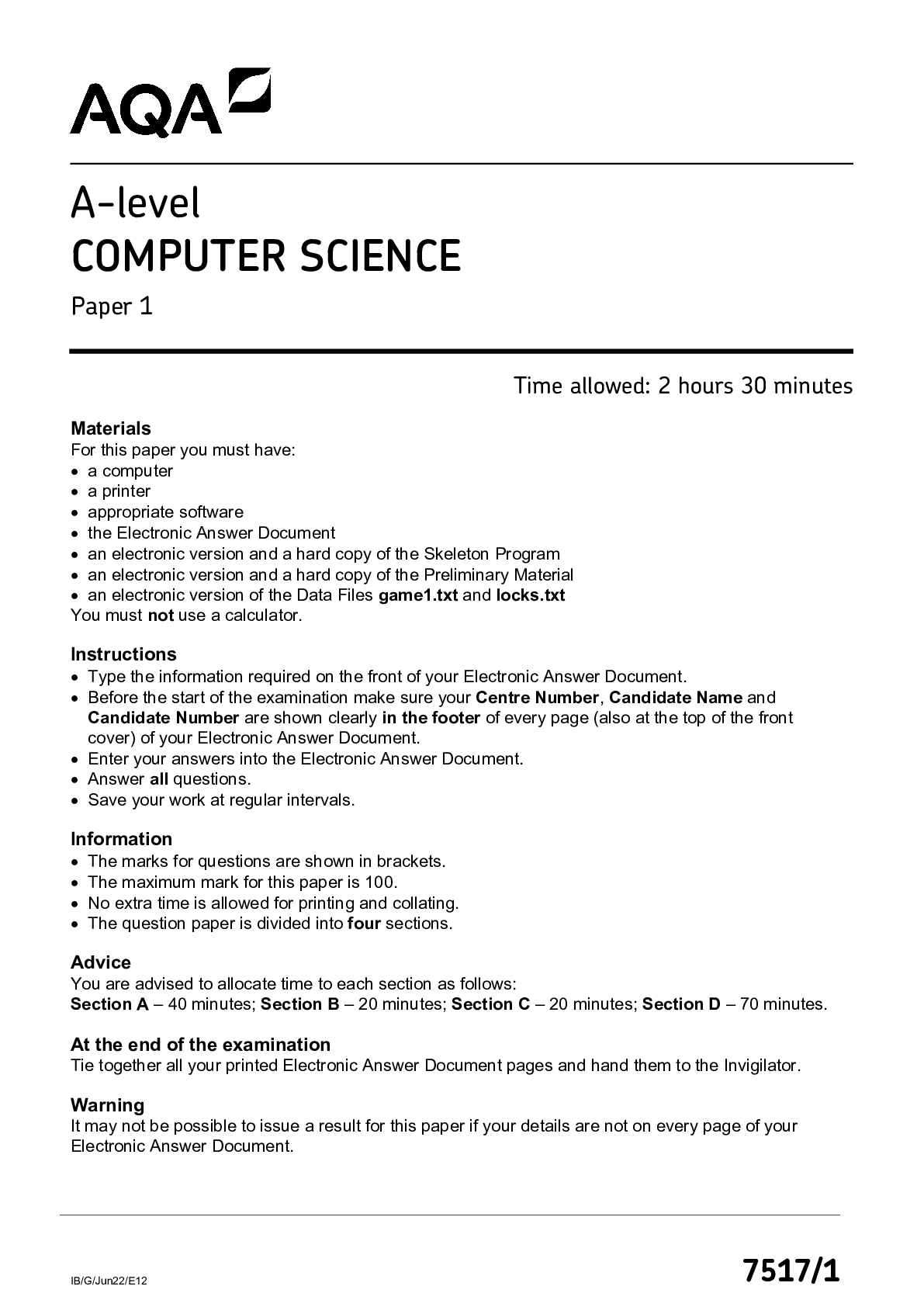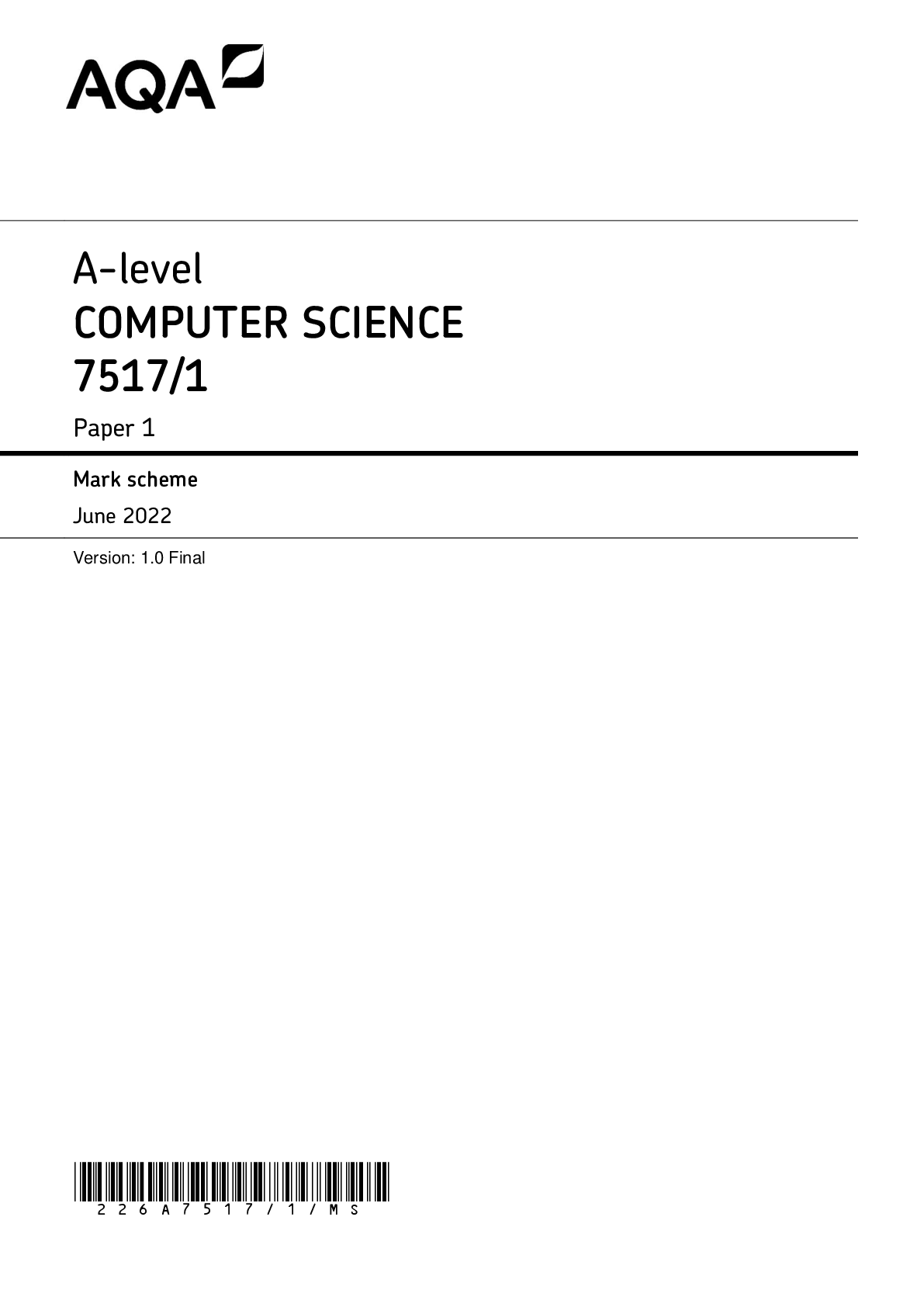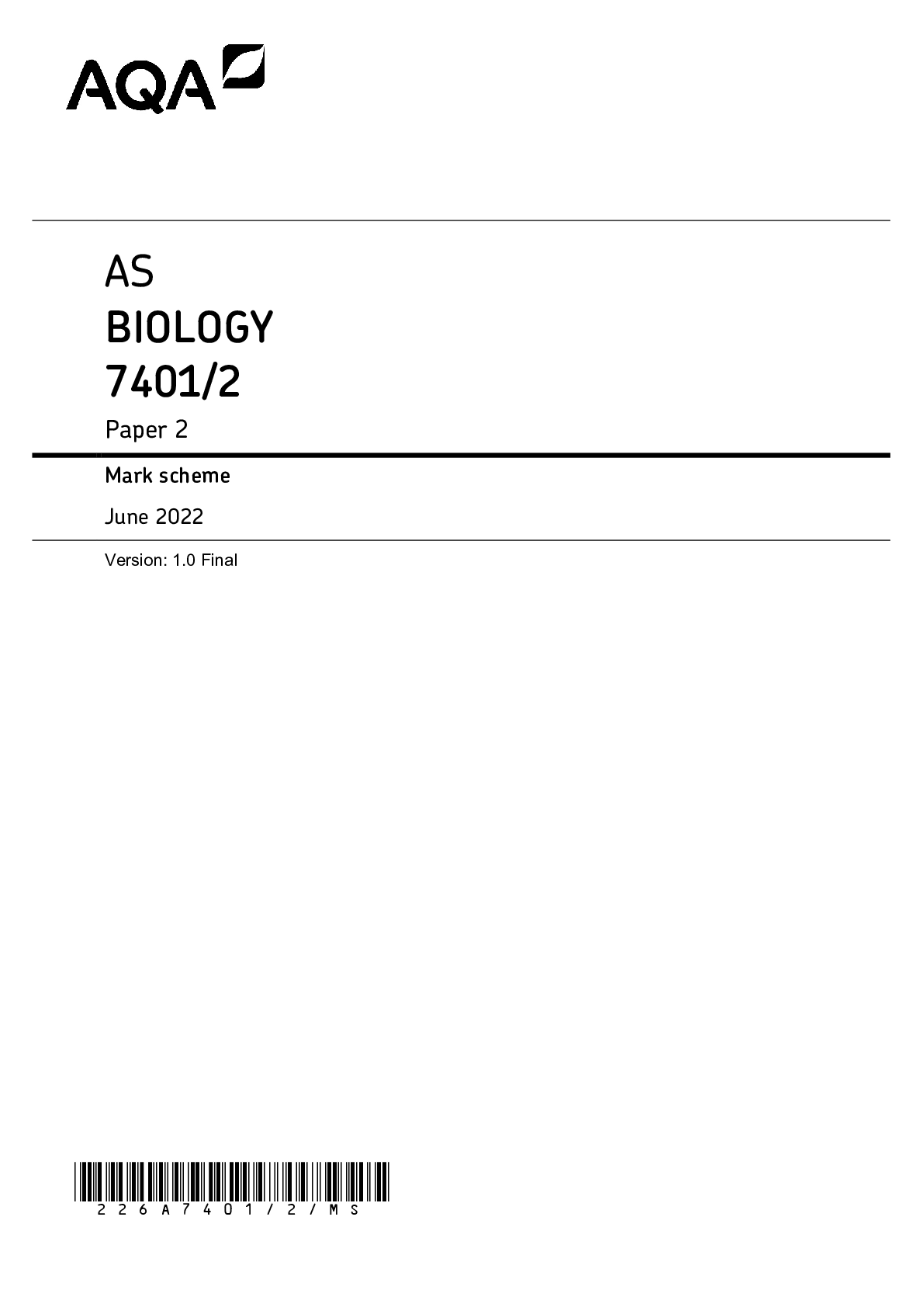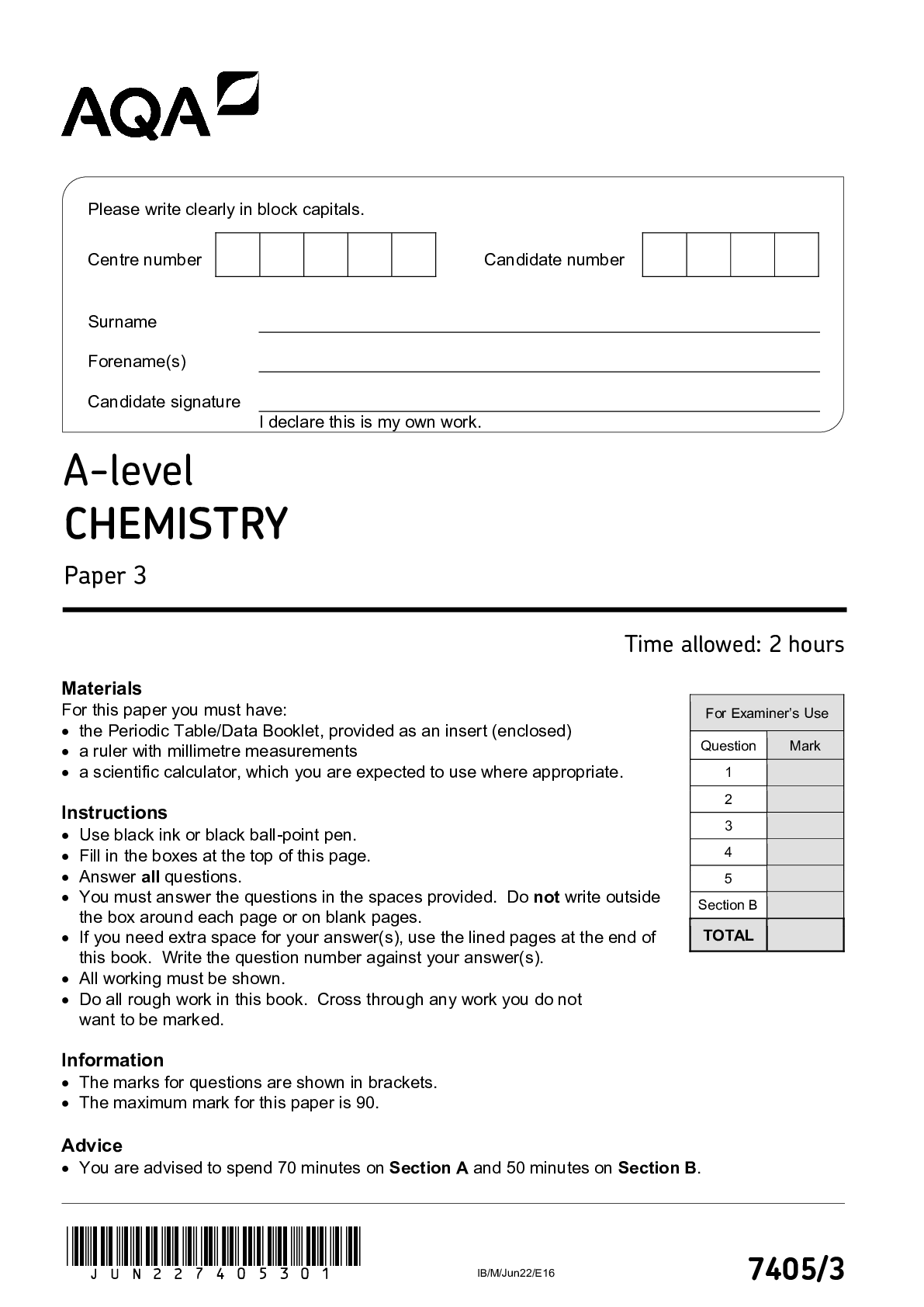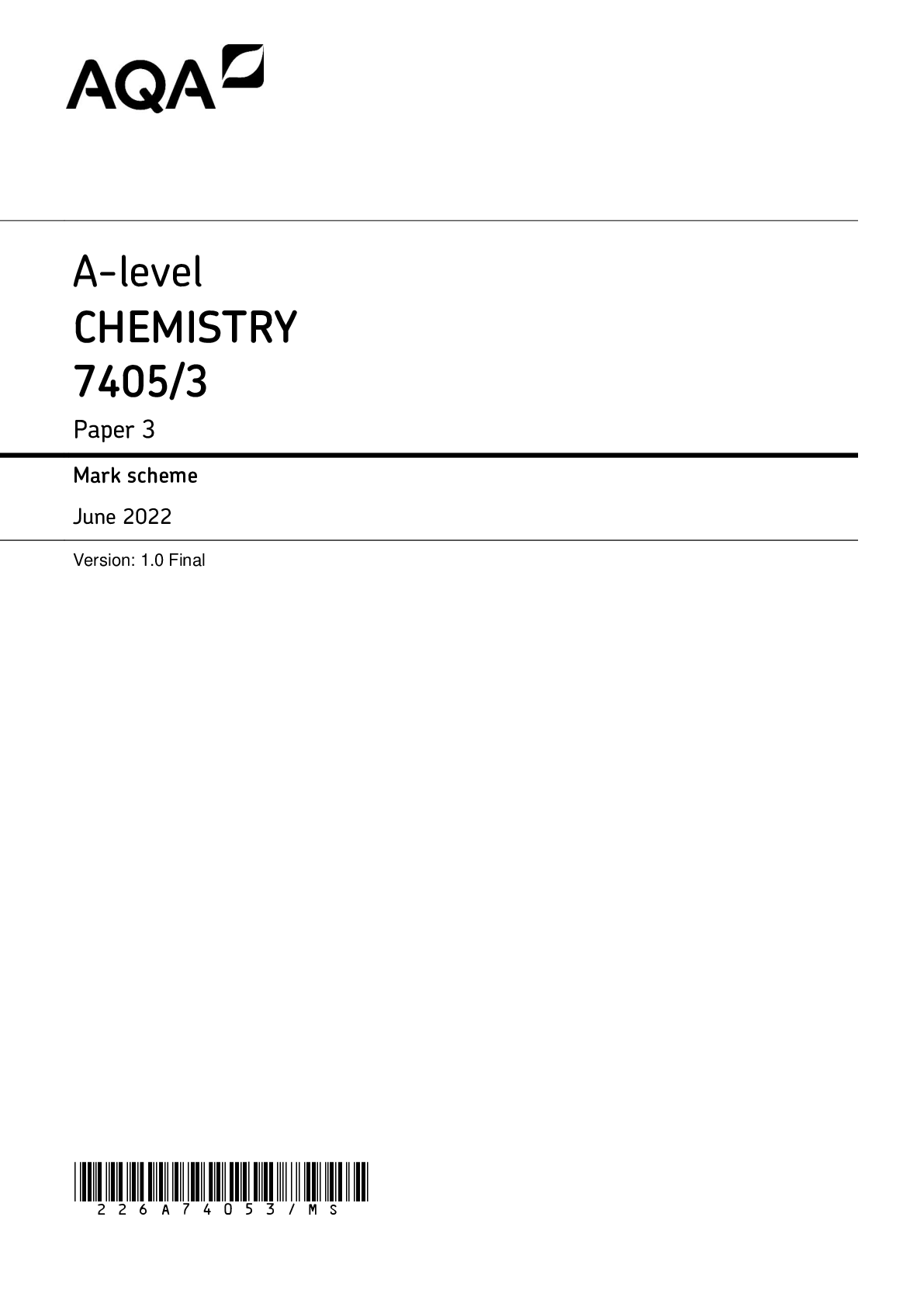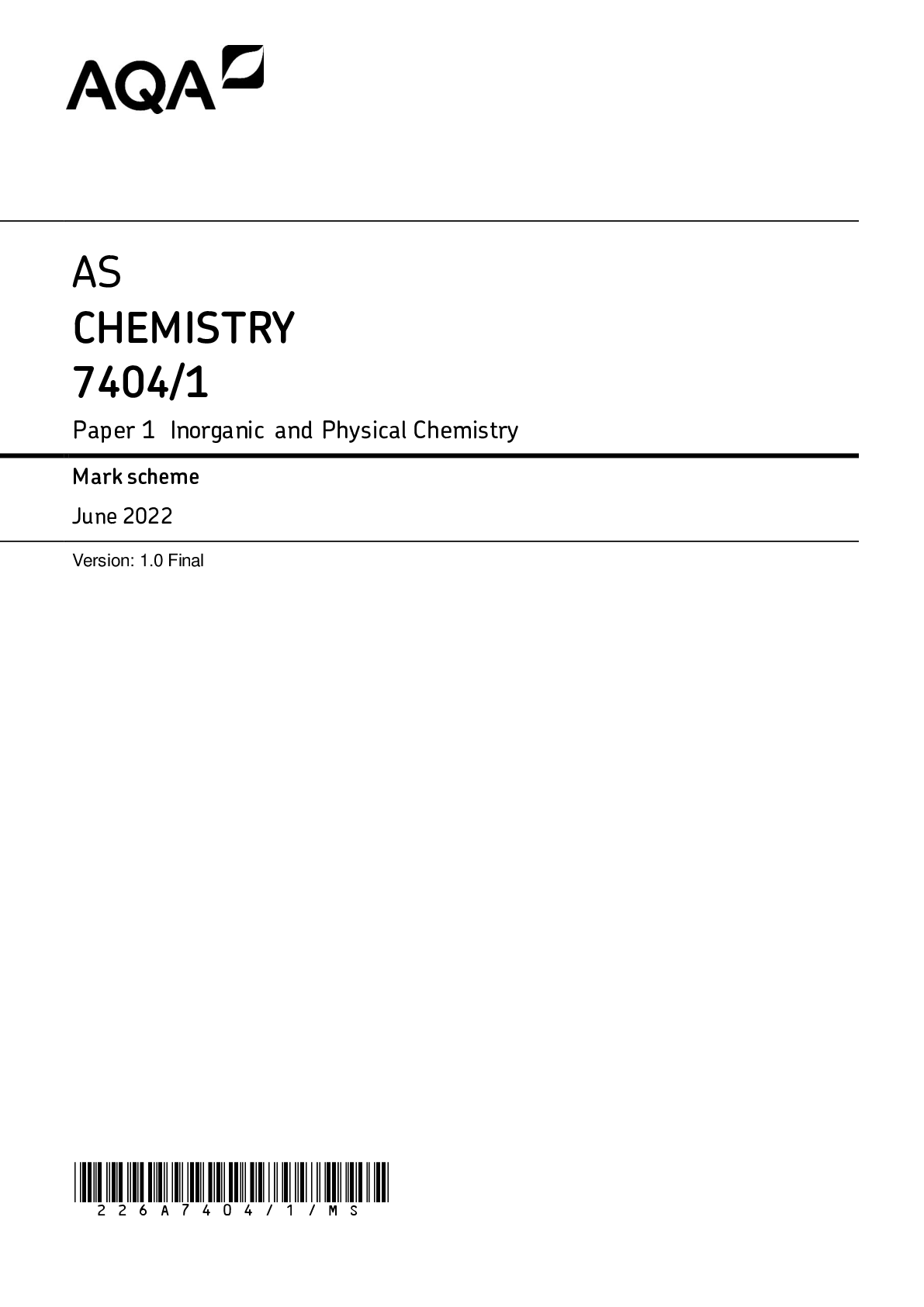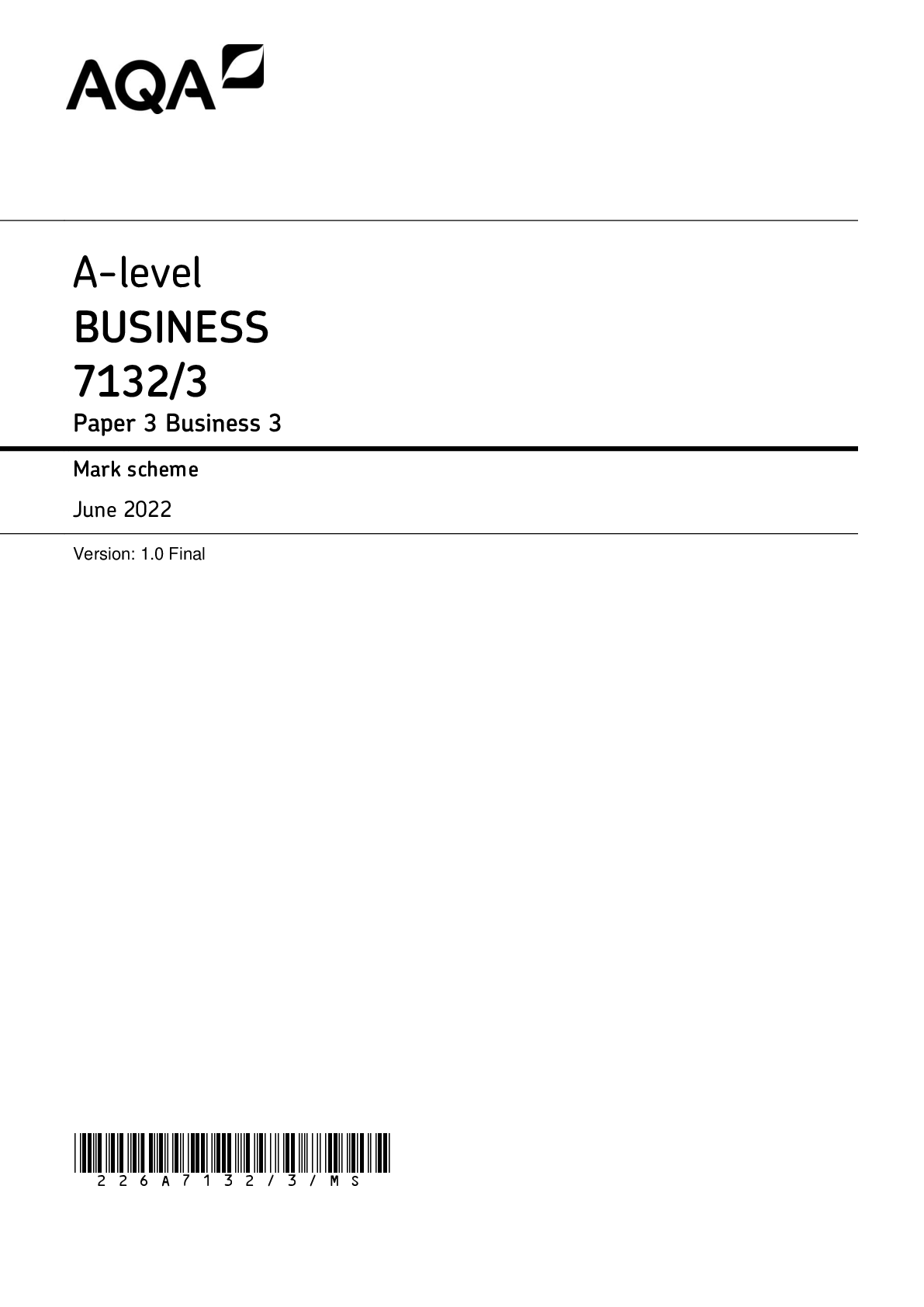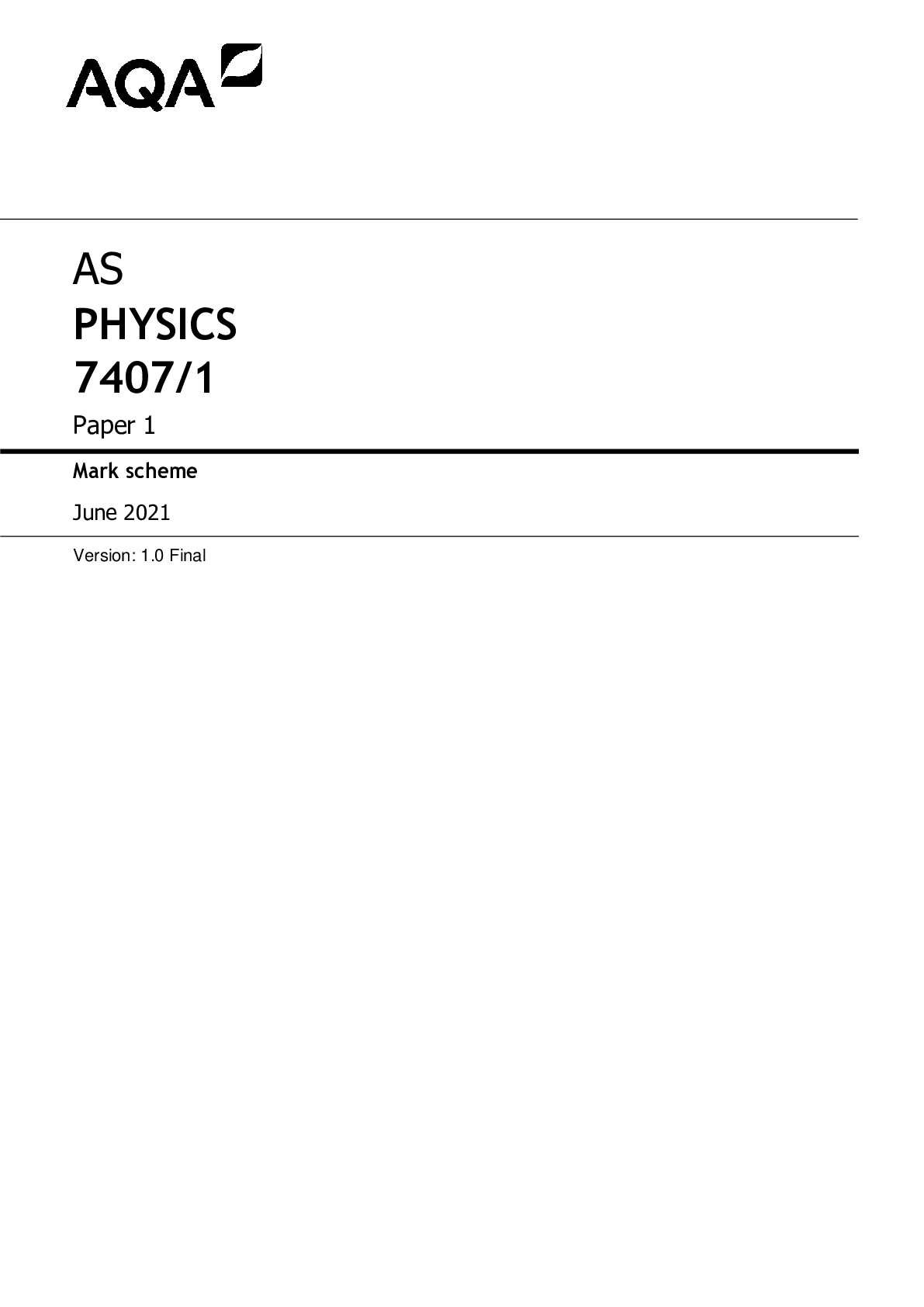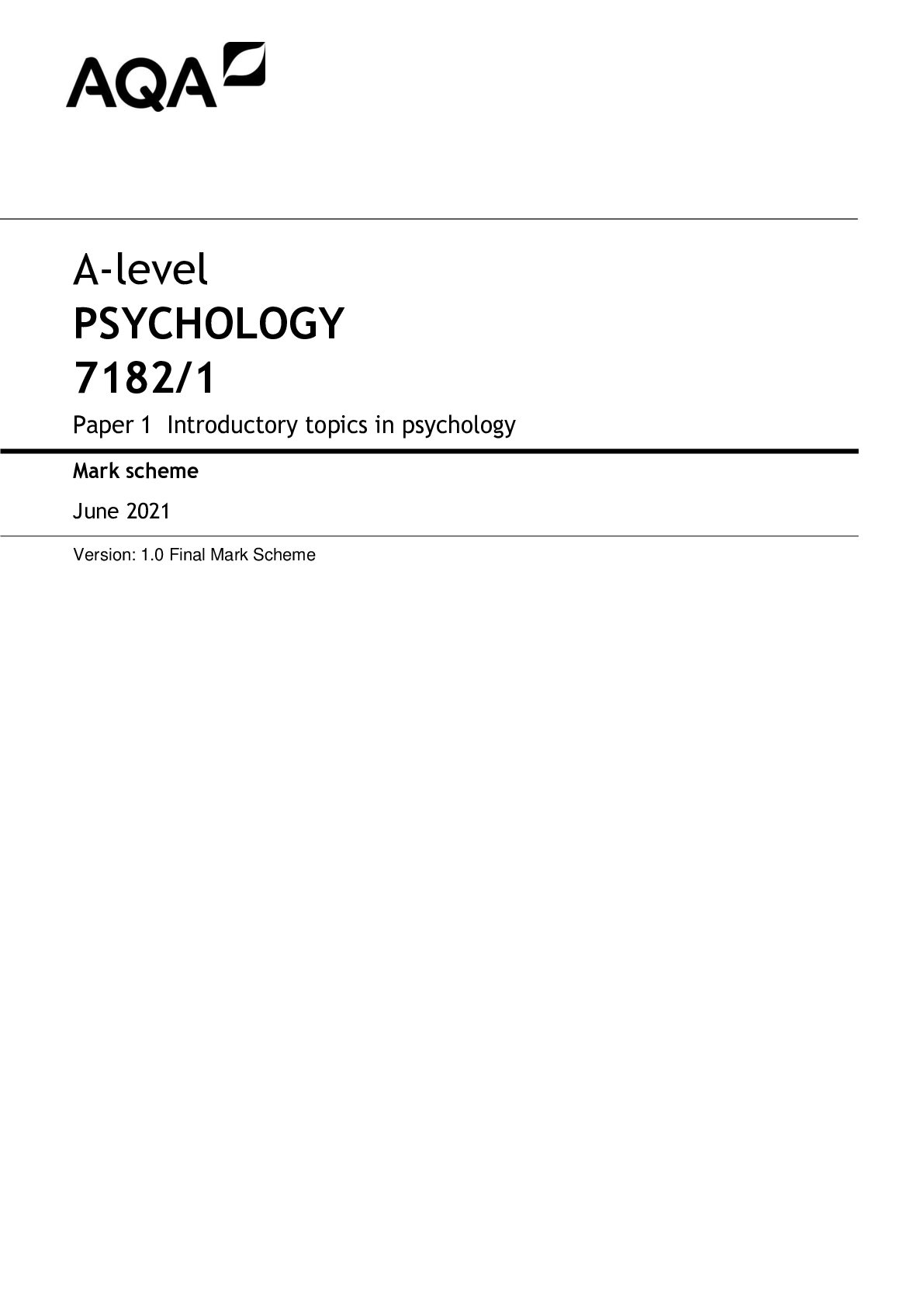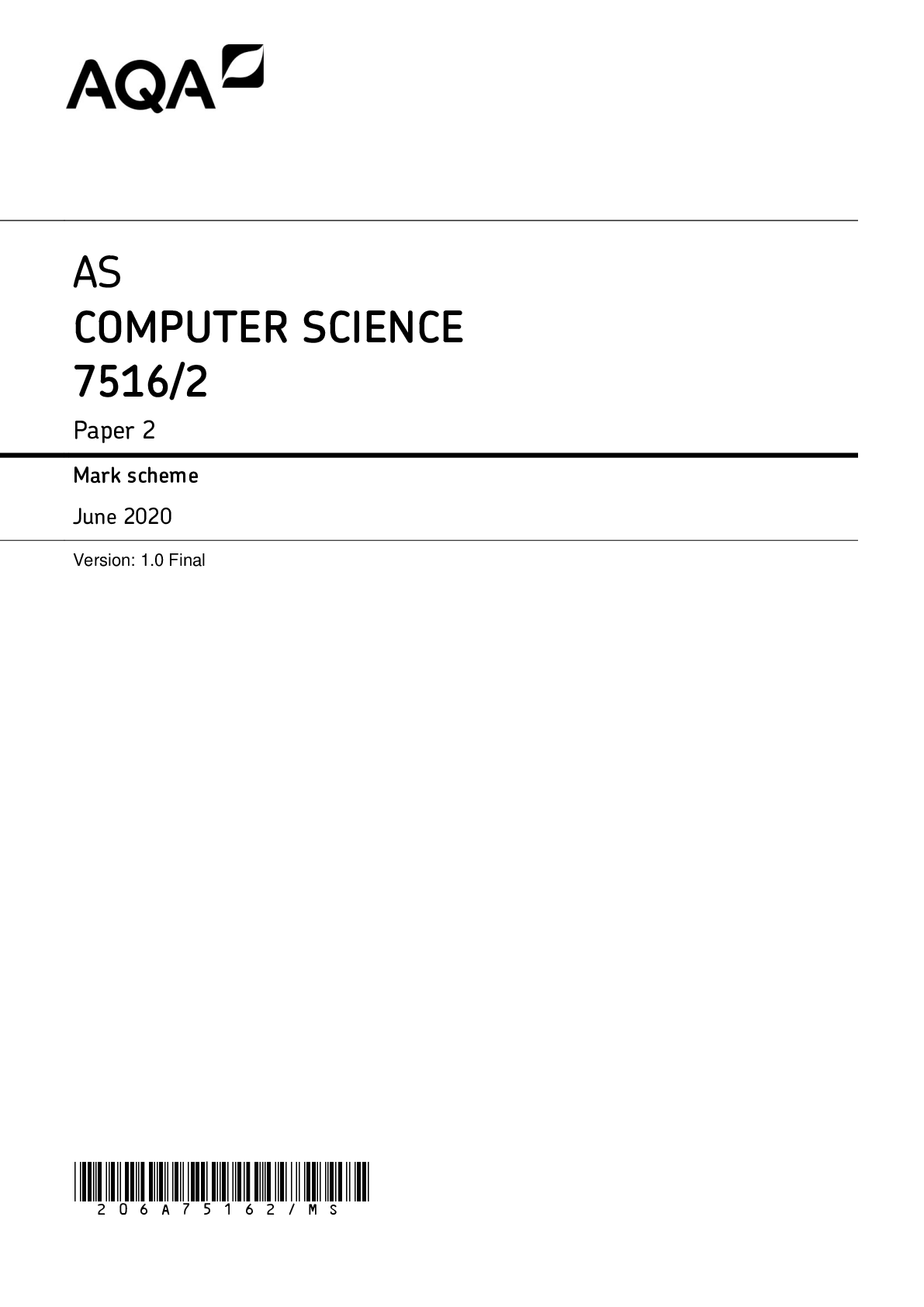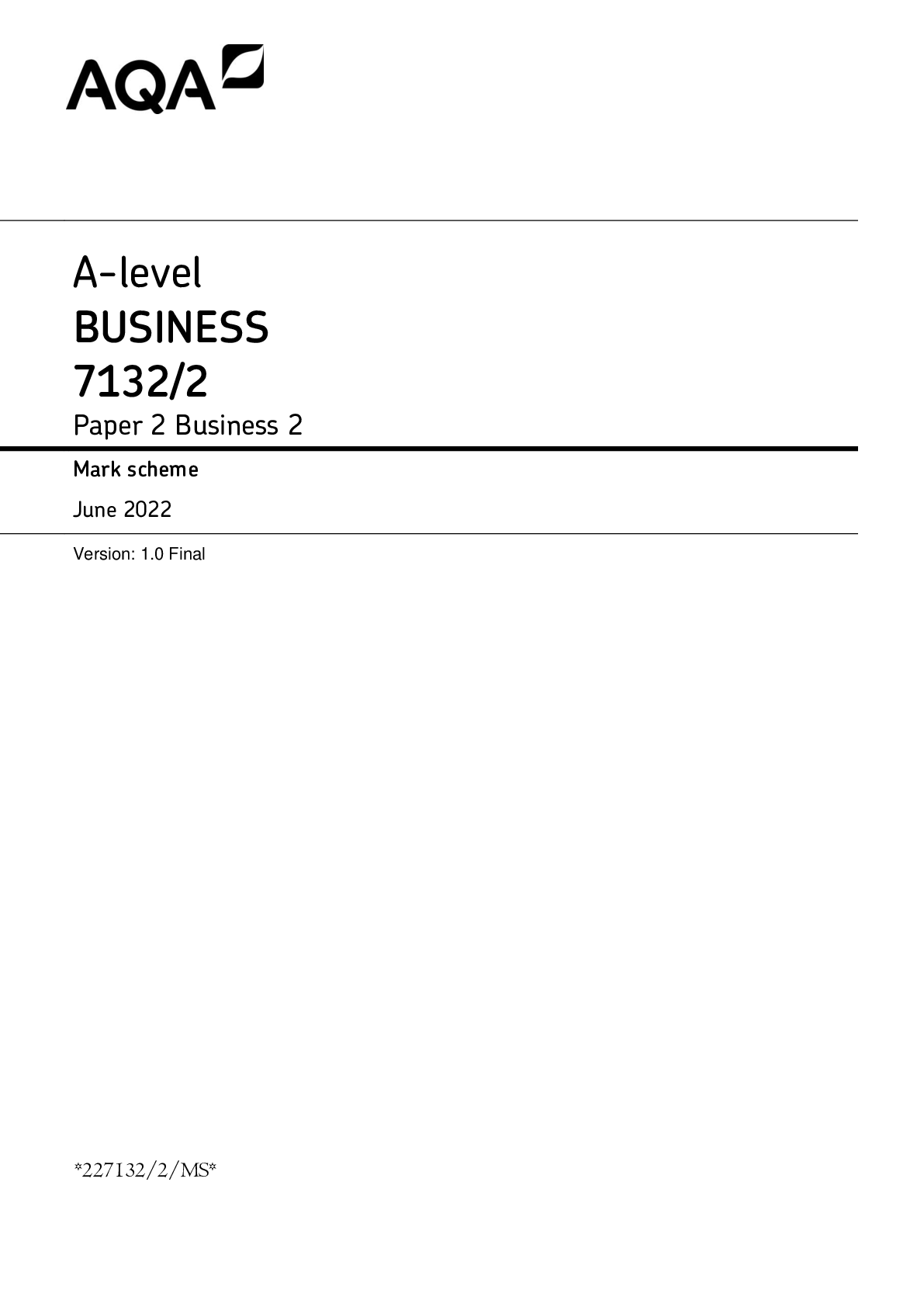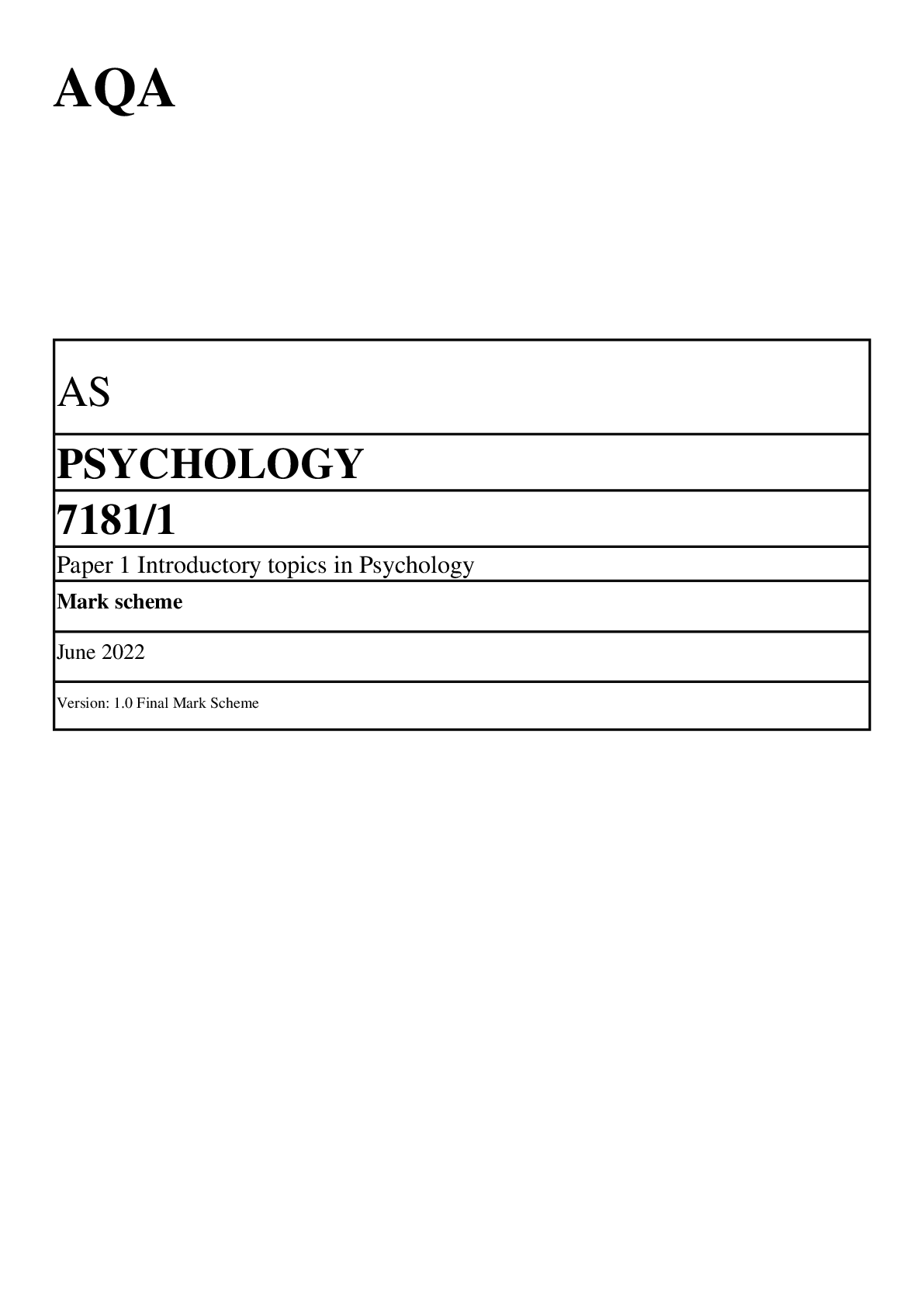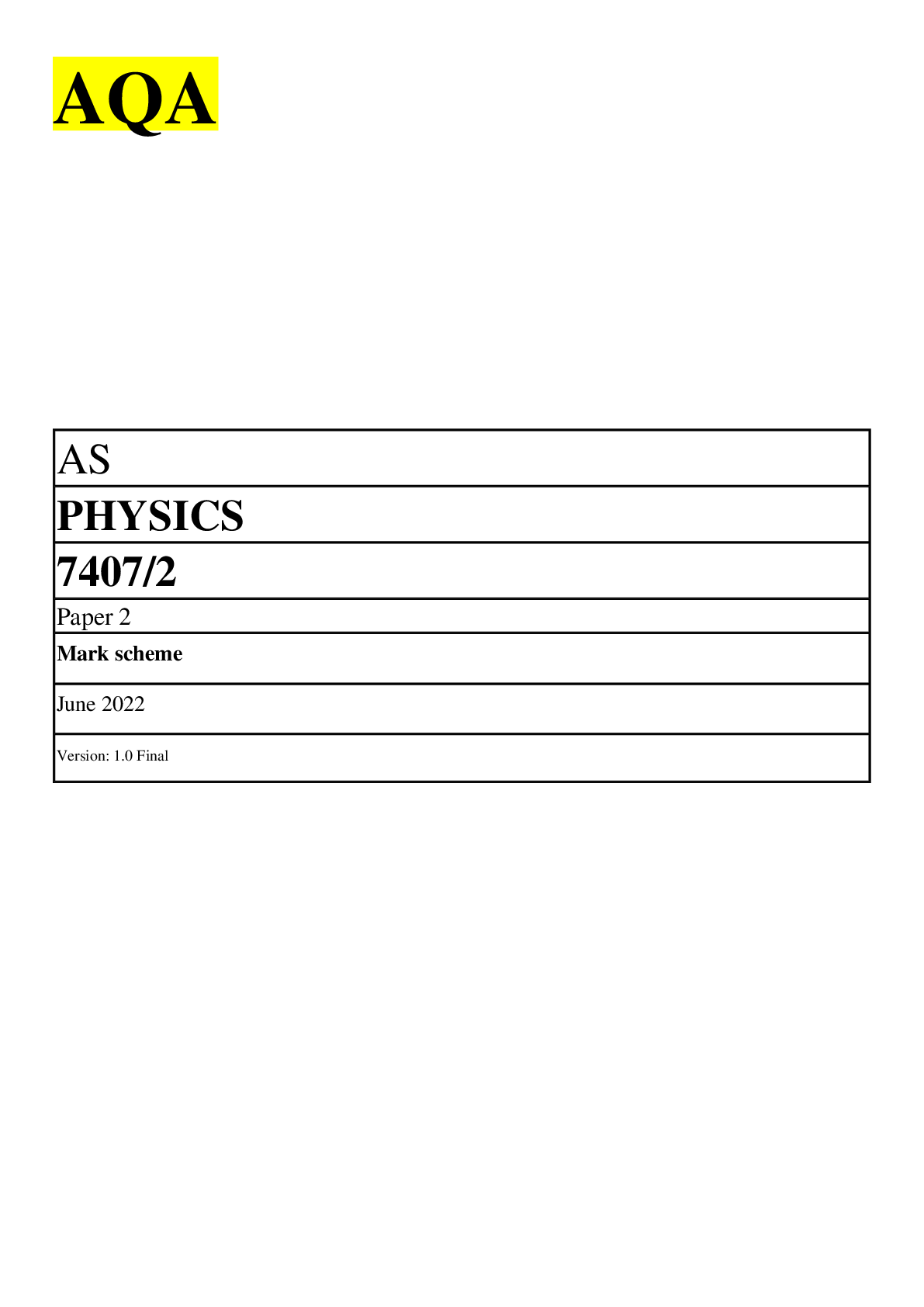Business > AS Level Mark Scheme > A-level BUSINESS 7132/1 Paper 1 Business 1 Mark scheme June 2022 Version: 1.0 Final Mark Scheme *226 (All)
A-level BUSINESS 7132/1 Paper 1 Business 1 Mark scheme June 2022 Version: 1.0 Final Mark Scheme *226A7132/1/MS* MARK SCHEME – A-LEVEL BUSINESS – 7132/1 – JUNE 2022 2
Document Content and Description Below
A-level BUSINESS 7132/1 Paper 1 Business 1 Mark scheme June 2022 Version: 1.0 Final Mark Scheme *226A7132/1/MS* MARK SCHEME – A-LEVEL BUSINESS – 7132/1 – JUNE 2022 2 Mark schemes are p... repared by the Lead Assessment Writer and considered, together with the relevant questions, by a panel of subject teachers. This mark scheme includes any amendments made at the standardisation events which all associates participate in and is the scheme which was used by them in this examination. The standardisation process ensures that the mark scheme covers the students’ responses to questions and that every associate understands and applies it in the same correct way. As preparation for standardisation each associate analyses a number of students’ scripts. Alternative answers not already covered by the mark scheme are discussed and legislated for. If, after the standardisation process, associates encounter unusual answers which have not been raised they are required to refer these to the Lead Examiner. It must be stressed that a mark scheme is a working document, in many cases further developed and expanded on the basis of students’ reactions to a particular paper. Assumptions about future mark schemes on the basis of one year’s document should be avoided; whilst the guiding principles of assessment remain constant, details will change, depending on the content of a particular examination paper. Further copies of this mark scheme are available from aqa.org.uk Copyright information AQA retains the copyright on all its publications. However, registered schools/colleges for AQA are permitted to copy material from this booklet for their own internal use, with the following important exception: AQA cannot give permission to schools/colleges to photocopy any material that is acknowledged to a third party even for internal use within the centre. Copyright © 2022 AQA and its licensors. All rights reserved. MARK SCHEME – A-LEVEL BUSINESS – 7132/1 – JUNE 2022 3 Level of response marking instructions Level of response mark schemes are broken down into levels, each of which has a descriptor. The descriptor for the level shows the average performance for the level. There are marks in each level. Before you apply the mark scheme to a student’s answer read through the answer and annotate it (as instructed) to show the qualities that are being looked for. You can then apply the mark scheme. Step 1 Determine a level Start at the lowest level of the mark scheme and use it as a ladder to see whether the answer meets the descriptor for that level. The descriptor for the level indicates the different qualities that might be seen in the student’s answer for that level. If it meets the lowest level then go to the next one and decide if it meets this level, and so on, until you have a match between the level descriptor and the answer. With practice and familiarity you will find that for better answers you will be able to quickly skip through the lower levels of the mark scheme. When assigning a level you should look at the overall quality of the answer and not look to pick holes in small and specific parts of the answer where the student has not performed quite as well as the rest. If the answer covers different aspects of different levels of the mark scheme you should use a best fit approach for defining the level and then use the variability of the response to help decide the mark within the level, ie if the response is predominantly level 3 with a small amount of level 4 material it would be placed in level 3 but be awarded a mark near the top of the level because of the level 4 content. Step 2 Determine a mark Once you have assigned a level you need to decide on the mark. The descriptors on how to allocate marks can help with this. The exemplar materials used during standardisation will help. There will be an answer in the standardising materials which will correspond with each level of the mark scheme. This answer will have been awarded a mark by the Lead Examiner. You can compare the student’s answer with the example to determine if it is the same standard, better or worse than the example. You can then use this to allocate a mark for the answer based on the Lead Examiner’s mark on the example. You may well need to read back through the answer as you apply the mark scheme to clarify points and assure yourself that the level and the mark are appropriate. Indicative content in the mark scheme is provided as a guide for examiners. It is not intended to be exhaustive and you must credit other valid points. Students do not have to cover all of the points mentioned in the Indicative content to reach the highest level of the mark scheme. An answer which contains nothing of relevance to the question must be awarded no marks. MARK SCHEME – A-LEVEL BUSINESS – 7132/1 – JUNE 2022 4 Marking guidance • Be clear on the focus of the question. • Read the response as a whole; follow the flow of the argument as a whole. • Remember that the indicative content provides possible lines of argument but there may be others that are equally valid. Be willing to credit other lines of argument. • Annotate the script as you read in accordance with the instructions given at standardisation. • Consider what it all adds up to, eg is this a good response? A reasonable one? A limited one? Refer back to the standardisation scripts and guidance to help you benchmark. You are marking to the standard agreed at standardisation. • Summarise your findings briefly at the end of the response. This will help you decide on the overall level and is helpful for others to understand the mark given, eg for an extended response ‘well-argued’ but does not focus fully on the issue of ‘long term’ feels as if it might be good rather than excellent. Make sure the comments fit with the level awarded: ‘unbalanced and not comparing with alternative solutions’ does not sound as if it is ‘good’. • Next to your comment put the level awarded, eg L4. • If in doubt about an approach contact your Team Leader, do not make up your own rules because we must have a standardised approach across all marking. Be positive in your marking. Look to reward what is there. MARK SCHEME – A-LEVEL BUSINESS – 7132/1 – JUNE 2022 5 Annotations for mark schemes Section B – 9-mark questions The following should be used at the end of the response Section C and Section D – 25-mark essay questions The following should be used at the end of the response: K U Knowledge and Understanding AN Analytical but lacks context ARG Argument DEV Developed argument J Judgement with support NFF Not Fully Focussed on the demands of the question Bal Balanced response, eg both sides acknowledged Rng Range of arguments, eg two arguments presented BOD Benefit of the Doubt NAQ Not answering the question OFR Own Figure Rule SEEN Seen TICK CROSS Txt Box ? Unclear Highlighter Highlighter [ REP ] Repetition L3 L3 A good response L2 L2 A reasonable response L1 L1 A limited response L5 L5 An excellent response L4 L4 A good response L3 L3 A reasonable response L2 L2 A limited response L1 L1 A weak response MARK SCHEME – A-LEVEL BUSINESS – 7132/1 – JUNE 2022 6 Section A Objective Test Answers Total for this section: 15 marks Question number Answer 01 B employees and shareholders 02 D the experience curve 03 C expected value minus the initial cost 04 C introducing fair trade principles 05 A from minus £10m to £30m 06 D 3 only 07 C product development, resulting from qualitative market research 08 A the market size, measured by volume, remains unchanged 09 B Statement 1 is true. Statement 2 is false. 10 C Statement 1 is false. Statement 2 is true. 11 C Statement 1 is false. Statement 2 is true. 12 D learning and growth perspective 13 A economies of scope 14 D Statement 1 is false. Statement 2 is false. 15 A achieve long-term growth MARK SCHEME – A-LEVEL BUSINESS – 7132/1 – JUNE 2022 7 Section B 1 6 Calculate the inventory turnover of Magpie plc. [2 marks] Marks for this question: AO1 = 1, AO2 = 1 Answer = 6.25 (2 marks) Inventory turnover = Cost of sales Average inventories held 50 8 = 6.25 or 6.25 times (1 mark for correct numerator OR denominator) + (1 mark for correct answer) (2 marks) Marker’s Notes If calculated in days the correct answer is 365 6.25 = 58.4 days (58 days) (2 marks) NB Award 2 marks for 58 or 58.4, with no reference to days. Do not award 2 marks if the correct measure is not used. For example, answers such as 6.25% or £6.25m are not correct, but should be awarded 1 mark. Similarly, award 1 mark for incorrect mumers based on the digits 6-2-5, such as 62.5 or 625. Award 1 mark for correct formula IF no valid calculation marks awarded. 1 7 Calculate the payables days for Magpie plc. [3 marks] Marks for this question: AO1 = 1, AO2 = 2 Answer = 87.6 days or 88 days (3 marks) Broken down as follows: Payables days = Payables Cost of sales × 365 12 (1 mark) 50 (1 mark) × 365 = 87.6 days or 88 days (1 mark) OFR applies, but ONLY if EITHER the numerator OR denominator is correct. Award 1 mark for correct formula IF no valid calculation marks awarded. MARK SCHEME – A-LEVEL BUSINESS – 7132/1 – JUNE 2022 8 1 8 Calculate the current ratio for Magpie plc. [3 marks] Marks for this question: AO1 = 1, AO2 = 2 Answer = 1.32 : 1 or 1.3 : 1 or 1.32 or 1.3 (3 marks) Current ratio = Current assets : Current liabilities 8 + 17 : 12 + 7 = 25 (1 mark) : 19 (1 mark) = 1.32 or 1.3 (Accept 1.31) (1 mark) OFR applies, but ONLY if EITHER the numerator OR denominator is correct. Award 1 mark for correct formula IF no valid calculation marks awarded. MARK SCHEME – A-LEVEL BUSINESS – 7132/1 – JUNE 2022 9 1 9 Analyse why non-profit organisations set financial objectives. [9 marks] Marks for this question: AO1 = 2, AO2 = 3, AO3 = 4 Level The student will typically demonstrate: Marks 3 A good response overall that focuses on many of the demands of the question. Provides an answer to the question set that: • demonstrates a depth and range of knowledge and understanding of issues in the question • demonstrates analysis which is well developed and is applied effectively to the context. 7–9 2 A reasonable response overall that focuses on some of the demands of the question. Provides an answer to the question set that: • demonstrates a limited knowledge and understanding of a range of issues in the question or a good knowledge and understanding of relatively few issues in the question • demonstrates analysis which is developed and is applied to the context. 4–6 1 A limited response overall with little focus on the demands of the question. Provides an answer to the question set that: • demonstrates a limited range and depth of knowledge and understanding of issues in the question • demonstrates analysis with little development and with mainly descriptive application to the context. 1–3 The demands of this question are: • to understand the meaning of non-profit organisations • to understand the meaning of financial objectives • to analyse the benefits of financial objectives for a business • to apply this analysis to non-profit organisations. Indicative content: • showing understanding of, or gives example(s) of non-profit organisations • explaining benefits of objectives, such as giving direction, providing a focus for decision-making, giving a sense of purpose to employees, and providing a yardstick against which actual performance can be measured and judged • using financial objectives, such as profit (or break-even) and cash flow objectives, in this analysis • recognising that financial objectives are needed by non-profit making organisations in order to secure their existence. Or pursue their corporate objectives. Marker’s Note: Maximum of 7 marks (low L3) for answers focused only on financial objectives. Accept all relevant arguments. MARK SCHEME – A-LEVEL BUSINESS – 7132/1 – JUNE 2022 10 2 0 Analyse how widening a manager’s span of control might affect labour productivity within the department she manages. [9 marks] Marks for this question: AO1 = 2, AO2 = 3, AO3 = 4 Level The student will typically demonstrate: Marks 3 A good response overall that focuses on many of the demands of the question. Provides an answer to the question set that: • demonstrates a depth and range of knowledge and understanding of issues in the question • demonstrates analysis which is well developed and is applied effectively to the context. 7–9 2 A reasonable response overall that focuses on some of the demands of the question. Provides an answer to the question set that: • demonstrates a limited knowledge and understanding of a range of issues in the question or a good knowledge and understanding of relatively few issues in the question • demonstrates analysis which is developed and is applied to the context. 4–6 1 A limited response overall with little focus on the demands of the question. Provides an answer to the question set that: • demonstrates a limited range and depth of knowledge and understanding of issues in the question • demonstrates analysis with little development and with mainly descriptive application to the context. 1–3 The demands of this question are: • showing an understanding of span of control • showing an understanding of labour productivity • analysing how an increase in span of control can affect the labour productivity of the department. Indicative content: • analysing how an increase in the span of control can reduce the ability of managers to monitor and support subordinates or lower morale and thus lead to lower labour productivity • analysing how an increase in the span of control can lead to increased delegation and greater responsibility for subordinates. This will lead to higher labour productivity because subordinates are motivated by responsibility and because tasks are carried out by people with relevant skills • analysing that a greater span of control will lead to fewer levels of hierarchy, which can improve the speed of communication (but which can lead to some subordinates being less likely to receive communications). Developing this idea to show the impact on the department’s labour productivity. Accept all relevant arguments. MARK SCHEME – A-LEVEL BUSINESS – 7132/1 – JUNE 2022 11 Additional guidance Credit should be given to students who use logical arguments to show the impact on labour productivity. Arguments that focus on levels of hierarchy should be rewarded, BUT only if the connection between increased spans of control and reduced levels of hierarchy has been esta [Show More]
Last updated: 1 year ago
Preview 1 out of 22 pages
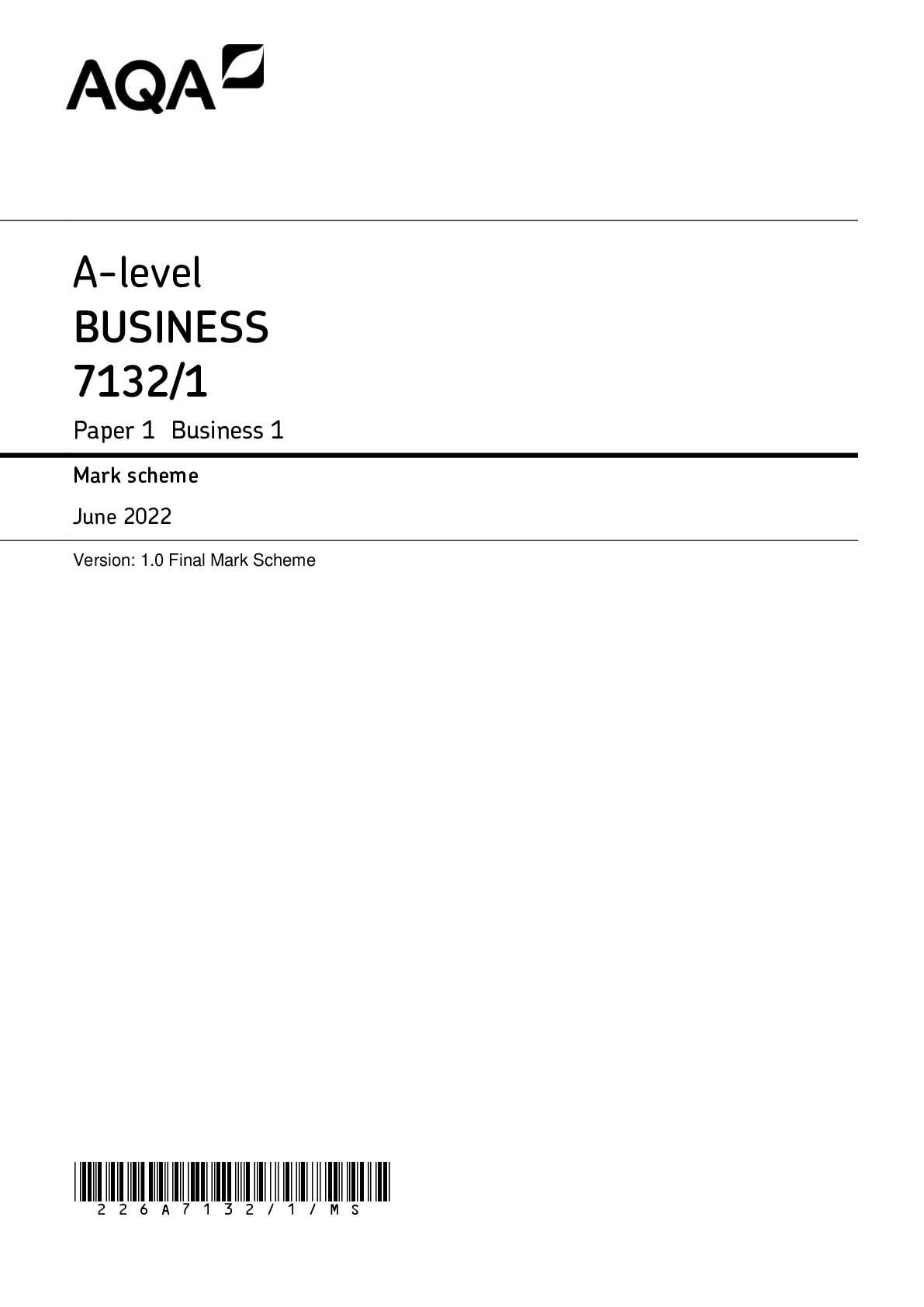
Reviews( 0 )
Document information
Connected school, study & course
About the document
Uploaded On
Apr 01, 2023
Number of pages
22
Written in
Additional information
This document has been written for:
Uploaded
Apr 01, 2023
Downloads
0
Views
110


